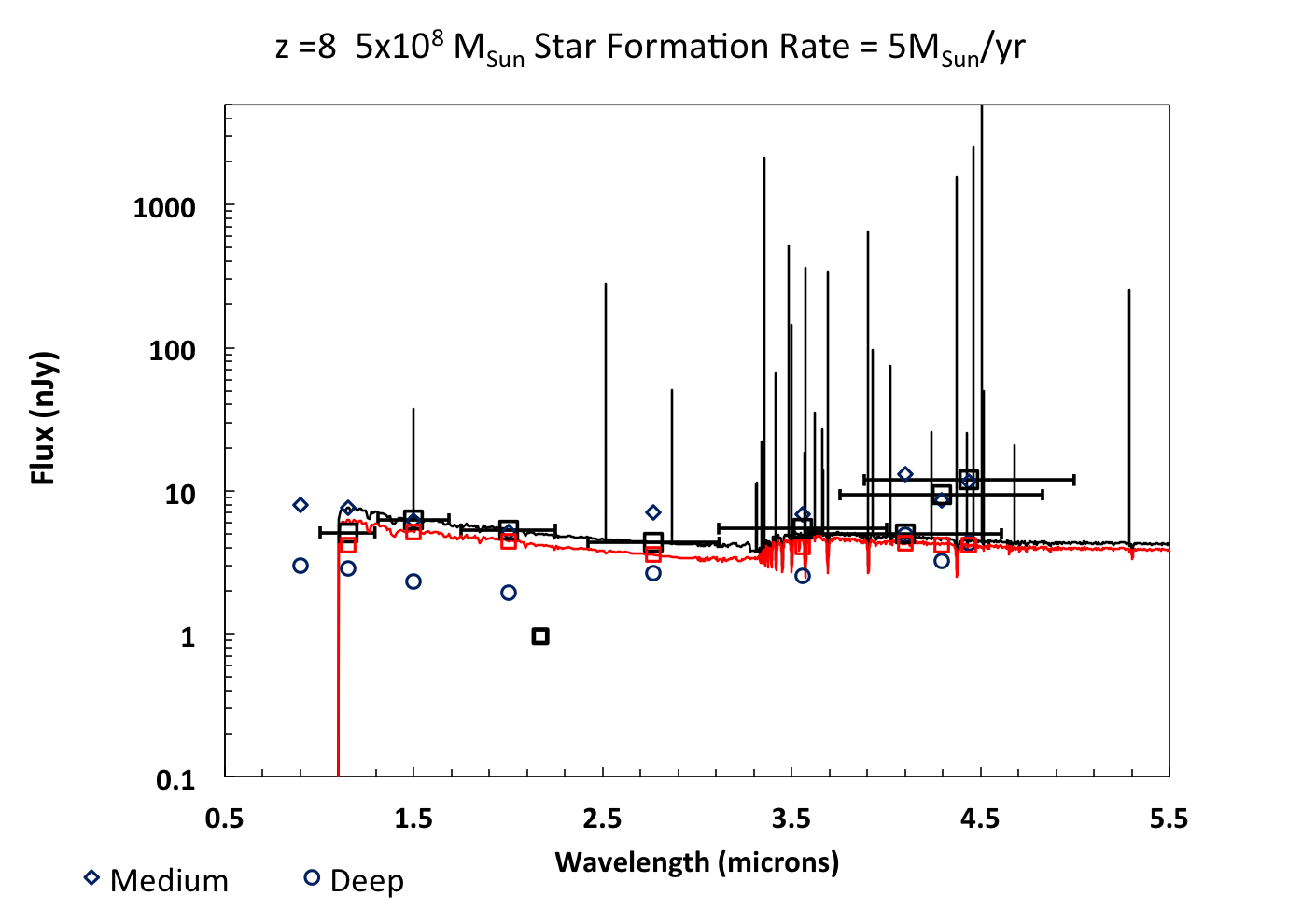NIRCam Deep Field Imaging with MIRI Imaging Parallels
This example science program demonstrates how to write a proposal for deep field imaging with JWST NIRCam Imaging and MIRI Imaging in parallel.
Example Science Program #22
Dated material
This example program was constructed pre-launch, and details may be out of date with actual observatory performance. However, it still provides a useful example for training purposes.
Please refer to JWST Example Science Programs for more information.
On this page
Science motivation
See also:
JWST Parallel Observations, Step-by-Step ETC Guide for NIRCam Deep Field Imaging with MIRI Imaging Parallels,
Step-by-Step APT Guide for NIRCam Deep Field Imaging with MIRI Imaging Parallels
This example, from a part of the joint NIRCam and NIRSpec GTO program, JADES (JWST Advanced Deep Extragalactic Survey) includes deep field imaging of the GOODS-S field (Figure 1). The goal is to study galaxy evolution from the first steps (z > 10) through the end of the dark ages (7 < z < 9) and through the epoch of galaxy assembly (2 < z < 6). Specific objectives include:
- Construct luminosity functions at the highest redshifts to test galaxy formation models
- Test ΛCDM by finding the highest redshift galaxies and estimating their masses
- Determine the halo masses of these galaxies
- Measure morphological parameters and assembly of stellar mass as a function of redshift
- Measure metallicity as a function of redshift
- Measure star formation histories
- Look for surprises!
This example science program describes what data are required to achieve the program's objectives, including discussion of the required wavelengths, spatial resolution, sensitivity, and spatial coverage.
Step-by-Step ETC Guide for NIRCam Deep Field Imaging with MIRI Imaging Parallels describes how to estimate the necessary imaging depth, and Step-by-Step APT Guide for NIRCam Deep Field Imaging with MIRI Imaging Parallels describes how to design the observation parameters. This program was presented as part of the JWST Proposal Planning Workshop at STScI in May 2017. Note that the program presented here is slightly different from the one presented at the workshop.
Step-by-step guide
Below we follow steps from the JWST Imaging Roadmap to design an observing program. See also the Getting Started with JWST Proposing.
Choose instruments
See also: NIRCam Imaging, MIRI Imaging, NIRCam Imaging Recommended Strategies, MIRI Imaging Recommended Strategies
NIRCam Imaging (0.6–5.0 μm) is the primary observing mode for this program, with MIRI imaging (5.6–25.5 μm) in parallel. The NIRCam observations will be deeper than the existing Hubble observations of GOODS-S and have superior spatial resolution at λ > 1 μm. The MIRI sensitivity limits will be 10 times those achieved with Spitzer and will have much better spatial resolution.
Check feasibility
See also: NIRCam Imaging Sensitivity, MIRI Sensitivity
For general guidance on depth vs. exposure time, we refer to NIRCam Imaging Sensitivity, and MIRI Sensitivity.
For this program, we refer to calculations by Crowley et al. (2018). Their simulations yielded expected number densities of galaxies at high redshifts, along with their detectability with NIRCam and MIRI imaging. They determined that 167 square arcmin of NIRCam imaging with a depth of 100 ksec would yield 10 galaxies at z = 12. A smaller NIRCam survey of 33 square arcmin at 10 ksec depth would yield 100 galaxies at z = 7. Here, we choose to cover 25 square arcmin with NIRCam at 30–50 ksec depth.
Select filters
See also: NIRCam Filters, MIRI Filters and Dispersers
To achieve maximum sensitivity, this program will use a combination of wide and medium NIRCam filters. Specifically, this program uses F090W, F115W, F150W, F200W, F277W, F356W, and F444W. F070W is not used because of its lower transmission. The medium filters used are F335M and F410M, which both overlap with a wide filter (F356W and F444W), helping to guard against emission lines in this wavelength region and providing additional redshift discrimination (Figure 2). The F410M filter is almost as sensitive as F444W, despite its narrower width, because the JWST background increases sharply at long wavelengths.
For the parallel images, this program uses only a single MIRI filter, F770W, to achieve sufficient depth.
Mosaic strategy
See also: JWST Mosaic Overview
The desired area (25 square arcmin) is larger than the NIRCam field of view (~10 square arcmin). We will use a 2 × 2 mosaic, as discussed in the accompanying APT Guide.
Dithering strategy
See also: NIRCam Primary Dithers, NIRCam Subpixel Dithers
Dithers are highly recommended for NIRCam imaging to protect against cosmic rays, improve the angular resolution, cover detector gaps, compensate for detector artifacts, and improve image quality. NIRCam is Nyquist sampled at 2 and 4 μm, so subpixel dithers are required for good spatial sampling for most of the wavelength coverage. Larger NIRCam dithers are also required to cover the detector gaps in the field of view (see below). MIRI is oversampled over most of its wavelength range and Nyquist sampled at F770W, so MIRI subpixel sampling is not required. Dither patterns for this program are discussed in the APT Guide.
Calculate required exposure times
The step-by-step ETC guide shows how to use the Exposure Time Calculator (ETC) to determine exposure parameters appropriate for the science goals for this program.
Design the observing program
The step-by-step APT guide demonstrates how to specify these observations in a JWST proposal using the Astronomer's Proposal Tool (APT).
References
Rieke, M. et al. 2019
Astro2020 Science White Paper: JWST GTO/ERS Deep Surveys
The JWST Advanced Extragalactic Survey (JADES)
Crowley, W, Baugh, C., Cole, S., Frenk, C., & Lacey, C., 2018, MNRAS, 474, 2352
Predictions for deep galaxy surveys with JWST from ΛCDM
CANDELS website
ACS Ultra Deep Field website
JWST Proposal Planning Workshop (May 2017) (See the "Agenda" tables for accompanying documents)

